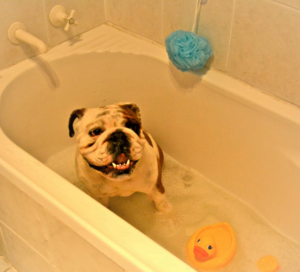Scalding temperatures can hurt your pets just like they can a human.
We all care about our children when it comes to hot water safety, so why not take the same care of our pets as well?
Our pets either love or hate bath time but a wash is an important part of their health and general wellbeing. It will not only keep them smelling fresh, but it will also help keep away any nasty parasites.
We know that washing your four-legged friend can sometimes be a struggle so we’ve got some handy tips to make the experience easier for both of you, whilst ensuring they stay safe in the process too. Our first tip – water temperature – plays a crucial part in bath time.
Bathe your pet in appropriately heated water. Around 37 degrees Celsius
- Brush your pet’s coat before washing
- Always test the water temperature before wetting your pet
- Hold your pet firmly
- Use the correct shampoo as recommended by your vet
37 degrees Celsius is perfect for most medium to large sized animals, such as cats and dogs.
Temperature can be reduced for older and smaller pets, as they are less tolerant to the heat. Similarly, avoid using cold water (such as from the garden hose) as pets find cold water uncomfortable the same as humans. As a general rule, lukewarm water is best for most animals.


On average, bathing your pet once a month is ideal, but this will vary depending on the thickness or oiliness of fur, and the sort of lifestyle your pet lives. Pets with an oily coat should be bathed once a week, and others with thick coats can go longer than a month without a wash as long as their fur is brushed regularly.
Take care to use pet shampoo, as recommended by your vet. Using human shampoo can dry your pet’s skin out, and always remember to rinse all soap out, so it doesn’t cause itching or irritation.
The plumbing industry adopted a new code of practice from 1st July, 2012 which requires all domestic hot water heaters to have some kind of mechanical temperature device. These types of devices could be a thermostatic mixing valve or the most commonly used tempering control valve.
A tempering control valve is generally fitted directly to the household’s main pressure storage tank, which can be either a gas or electric operated tank. The valve mixes the higher stored water temperature inside the tank (averaging 65 degrees) with the cold water house supply resulting in a mixed delivery temperature of no hotter than 50 degrees into the home.
This plumbing requirement is mainly required for bathroom areas only and in some homes may only control these areas of the home.
If you wash your pet in a bathroom area then you’re one step closer to keeping them safe as it’s possible that the hot water flow to the tap you’re using will be controlled by the tempering device at your water heater.
However, if you wash your pet from a laundry or kitchen area it’s possible that these hot water outlets are at full temperature and could scald your pet if not tested first – OUCH! To be safe, it’s a good idea to use a basic hand-held thermometer to test the water from these taps before washing.
Pets come in all shapes and sizes but the common rule to safeguard your beloved animal is to treat bath time like you would a human baby and only use luke-warm water to ensure there is no harm.
If you have a larger pet and need to wash them in an outside environment, a garden hose is okay to use if it’s a hot day – but always remember pets don’t like being cold any more than we do. Generally, a tub or bucket of luke-warm water to poor over your pet would be a more comfortable experience.


Australian Hot Water can help make sure that the hot water temperature in your home is suitable for not just humans but pets as well. We have a range of new hot water systems that either come with temperature control or we can supply and fit a device to your existing water heater.


